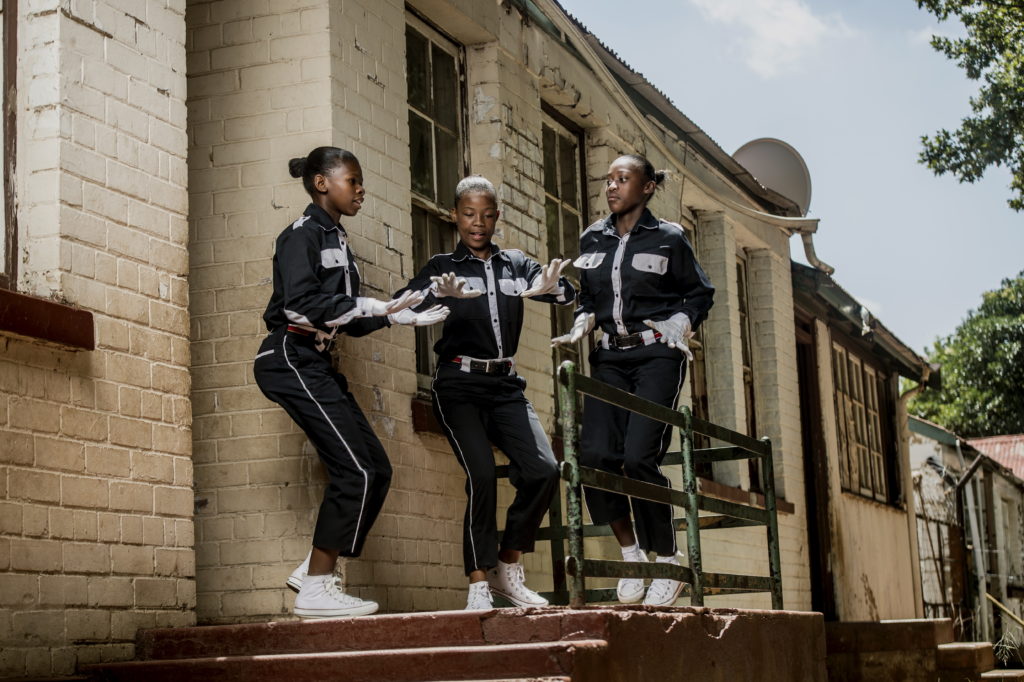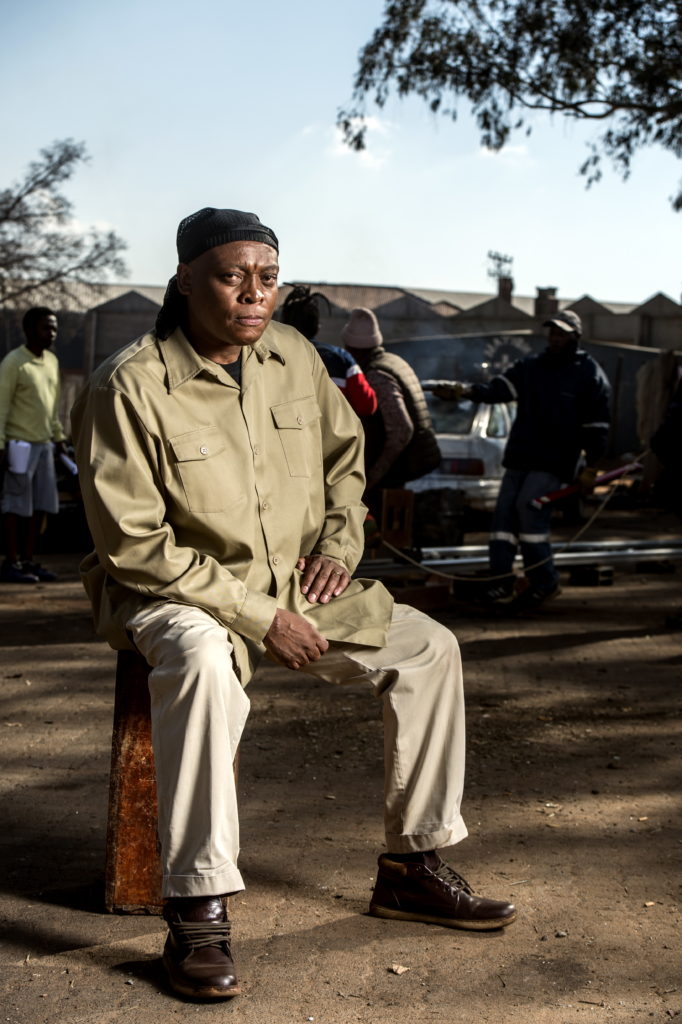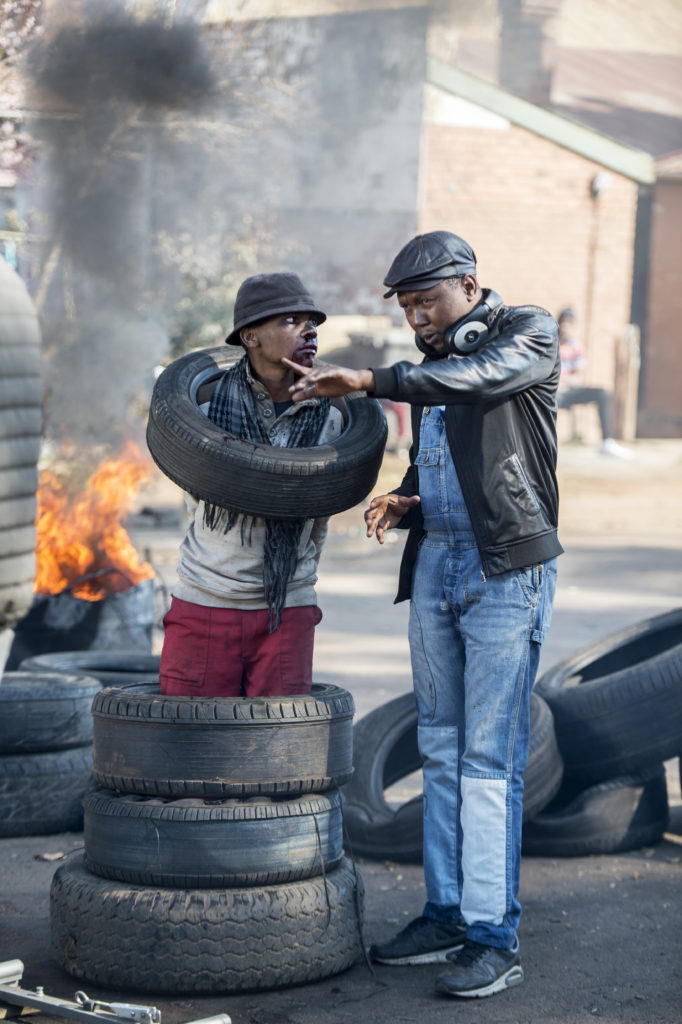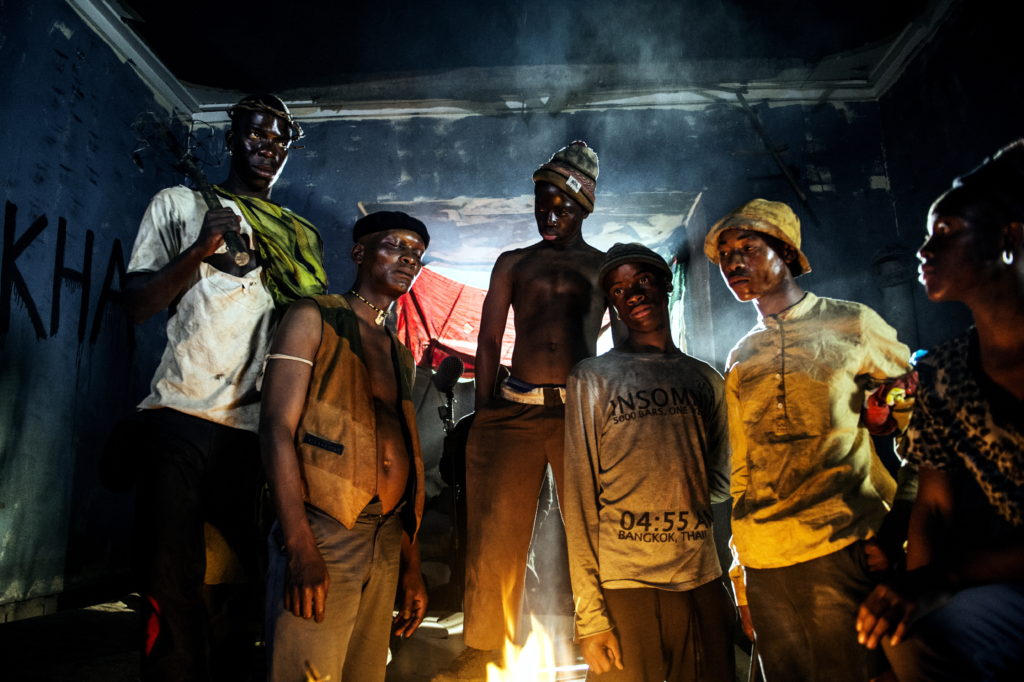Warren Masemola plays Mafred, an outsider of sorts and leader of amaTjovitjo, a dance troupe named after the fictionalised setting. (Siphiwe Mhlambi)
Judging by how fast it climbed up Netflix’s most-watched list, many people, not just South Africans, spent a significant chunk of last weekend watching Tjovitjo, the wildly popular Puo Pha production that throws ispantsula into a contemporary yet nostalgic setting. Under documentarian Vincent Moloi’s direction, the dance, the culture, the attitude and the setting all coalesce to propel this almost free-form rendering of survival, squalor and transcendence that debuted to an unprecedented reception in 2017, breaking SABC 1 viewership records.
In anticipation of season two, which debuts on Netflix on April 29, Moloi relays the story’s inception and how his background as a documentary filmmaker influences his artistic choices when it comes to drama.
 Inspired by pantsula culture and its embodiment of South African history, Tjovitjo is populated by frenetic, often competitive dance scenes. (Siphiwe Mhlambi)
Inspired by pantsula culture and its embodiment of South African history, Tjovitjo is populated by frenetic, often competitive dance scenes. (Siphiwe Mhlambi)
How did the idea of Tjovitjo come about?
I think the most important moment was when I was young in Soweto. We were watching a school soccer game between these two rival schools. One kid just walked into the field and started dancing. The whole game stopped and both teams and the students were cheering. For a moment nobody cared about soccer. It took about five or ten minutes to get him off the ground. I thought, “Damn, that kid has so much power, to stop 22 young men from playing the most favourite sport.” Bekajaiv’ ispantsula, and yet I wasn’t seeing this on TV. And I was like, “Yessus, this should be on TV”.
You were having these thoughts as a child?
I think I was about 14, 15. Even when my parents said, “Hayi, ijive yabo tsotsi le”, and what not, it had such a huge following from everyone in the street. There was just such a big disconnect, even back then, between what was on TV and what was on the street. Later on in life when I became a filmmaker, the kinds of stories I’m attracted to are those that I know very well and those that I know are not being told, if you look at the history of the documentaries I’ve done or even dramas that I have come up with. A Pair of Boots and a Bicycle was about black South African soldiers in World War II. I didn’t even know that story until I researched it and made the doccie. You look at Skulls of my People; I tend to be attracted to stories that are not in the mainstream but I know that they matter. I know that ispantsula matters. So when I was looking at what type of fiction I can do, that story of the pantsula came through.
I actually didn’t have anything else. But I knew I wanted to tell a story about a culture and about a people. And I pitched it for about four years to all the broadcasters that we had in this country and they all said no for various reasons. I think one of the most common reasons was, “Why would you wanna do something on ispantsula? That culture is dead, no one is gonna watch it.” I go to the hood and I find people that are still dancing it. They are not in the majority but they are there. It’s a culture that has survived years in a world where cultures evolve quite rapidly or die. Yet this has remained. Without resources, without influence, without [much] support.
 Veteran actor Rapulana Seiphemo (who plays Terror) forms part of a cast of experienced and novice actors in Tjovitjo. (Siphiwe Mhlambi)
Veteran actor Rapulana Seiphemo (who plays Terror) forms part of a cast of experienced and novice actors in Tjovitjo. (Siphiwe Mhlambi)
There are many different stories about its origins …
A common one that I’ve heard is that it’s a dance that was meant to express pain and it’s a combination of many dance genres. Some people say it includes many forms of traditional dancing that were there because of the urbanisation of South Africa. So it’s a street culture that happened organically from that. Another strand is that it was an expression of anger at being oppressed. “So we are going to send codes to each other without being noticed by the authorities.”
How did you come across the setting and the visual language with which to tell the story because so much of it is about the environment in which the dancing happens? And Warren Masemola – he is quite clearly the centre piece, almost bigger than the place and the story?
I got a lot of beef from a lot of people from both sides; from the broadcaster itself and from the pantsula guys themselves who were in urban areas. They were like, “Warren (who plays Mafred) is not a Jozi guy. He’s not from Alex or Soweto. Why does he speak like that? We need to give it the flavour of the people who live and speak the culture.” I had to fight a lot of pantsulas because they were naive to the fact that this culture has spread all over South Africa. People have migrated between Joburg and their villages. And when people get there they adapt and embrace the culture and live by it because of what it represents.
I myself had to leave Soweto and go and live in QwaQwa. My parents sent me there and I found pantsulas there. From a story point of view, it’s more interesting to me when the lead doesn’t use township lingo. It’s an outsider. But it’s an outsider who has taken over the culture and is a leader in the culture. That gives more layers. Some people felt I needed to explain that in the story, but I felt like you either accept him, because he has embraced the culture and he is the culture, or you don’t.
Some custodians in the township didn’t buy into that. Some people in the institutions didn’t buy into that but it’s amazing how the masses have embraced it.
And the location …
It’s around Crown Mines. I was driving to Soweto after work, about ten years ago. Because there was traffic on the main road, I’d cut corners and one day, as I was driving, I saw this old mining house. I was just like, “Yessus”. Artistically, it looked good but it also represented the past. I wanted to see who were the people who were living there. I drove in. They used to have lots of trees. And you could only see one house and wouldn’t see whatever else was behind. And it was like a curtain opening. It was a whole new world.
Lots of these houses. Lots of people, a squatter camp in there. People singing. There were taverns, even the zama-zamas were there. Just a whole new world hidden away from the street, almost like a cocoon. I swore that one day I would come in and do a project there because of what it represented.
As an old mining town it represented wealth because this is where the managers of the mines were kept, but now it’s occupied by people from everywhere.
It’s also a reflection of our society now. We had hope for a good life, somehow all of us are disappointed.
The location is a character too.
A lot of the criticism I get with Tjovitjo is that we don’t have a story. It’s been the biggest one. To a certain extent I agree. But in my head, I believe the story is not in the mechanisms that are conventional. Just being there, the texture of the place tells you a lot; just how it attracted me and how I had my own reading of it. You don’t have to say anything, you just need to see it’s texture and you will have a story in your head.
The people who built shacks on that land are all from somewhere. Some hired rooms there and left to the houses and started building shacks using the natural structures [of the houses], which was the environment. The heart of everything I do is in what I find there. It comes from my background as a documentary maker. That’s the attitude I took into fiction.
 Vincent Moloi directing a scene in an upcoming season of Tjovitjo (Siphiwe Mhlambi)
Vincent Moloi directing a scene in an upcoming season of Tjovitjo (Siphiwe Mhlambi)
Tjovitjo struck a major chord with people, breaking viewership numbers. What do you think audiences were responding to?
A number of things. The main one is that there’s lots of people living in an environment like Tjovitjo who are just as destitute and they are looking for hope. They can resonate with that situation. There’s people who have been longing for a culture and a dance that authentically expresses who they are. There’s a greatness about honesty and being naked about who you are.
Another thing is that people were tired of telenovellas looking like dramas. Same grading, same superficial representation of who we are. That’s why they could forgive us if we didn’t use traditional storytelling.
There’s a quality to the cinematography that makes it seem like we are straddling eras, much like the location.
Again, as a kid, when I had an interest in that culture, I remember these two guys who were battling and they were dressed beautifully. They were clean but where they were dancing was ugly. It was in a squatter camp. There was a nice contrast in that. When I started thinking about the lenses and cameras it was an attempt to reenact what I remember in my childhood – a combination of beauty and grit and all its imperfections.
I used three DOPs [directors of photography]. One of them, Marius van Graan, made the point that the show was about memory. I have these glasses that I have fixed to the lenses. They are cut almost like diamonds. If you shoot against the sun it will give you some flares and flares represent memory.
When someone asked, “when did you decide to shoot at that place because I can’t place it? I can’t tell which period it is?” I was excited because it meant the idea came through.
The soundtrack was very contemporary even within that idea of memory?
Because the culture itself has managed to survive through all these musical trends. It’s still dancing to the soundtrack of today. Some people were saying give us those sounds zak’dala but we couldn’t because the kids are still current.
Oskido, who was involved with the music took it a step further and said: “you don’t want to just use just old songs. I’m gonna give you songs that are still coming.” One of those [artists] was Sparks Bantwana. He hadn’t come out at the time and I see he’s getting traction again.
 Things heat up in the second season of Tjovitjo, with dance competing for space with the existential angst familiar to many South Africans. (Siphiwe Mhlambi)
Things heat up in the second season of Tjovitjo, with dance competing for space with the existential angst familiar to many South Africans. (Siphiwe Mhlambi)
Do you think you strike a balance between beauty and squalour? Some have argued that it borders on a fascination with poverty.
It’s not that I dwell on the world of poverty and squalour. It’s just the world of the people I’m trying to represent. I wasn’t trying to find a balance. My characters, in real life, are not in the balance. Their dreams and desires are squashed by the squalour.
Sometimes you have to amplify the issue to the point where it bothers people because they need to have a rude awakening about the reality of many other people in this country.
When is more coming?
Season two hits Netflix on April 29. It represents a particular time in my life. Most people didn’t like season two because it was so uncomfortable. With this project being an independent project done with my own money, we were basically shunned. I took a moment and said: “here we are doing something great but we are not getting support.” I was angry with the environment I am living in as a black person. It was also around the time of service delivery protests, so it was about reflecting on being let down and the anger that gets expressed as violence. I went a step further; where dance is banned and two people are fighting. In a world where the only thing you have is taken away, what do you do to take it back?